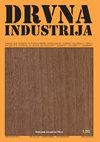传统与现代木结构角接缝的拉伸性能研究
IF 0.8
4区 农林科学
Q4 MATERIALS SCIENCE, PAPER & WOOD
引用次数: 0
摘要
角接缝是木结构的关键点,不仅在家具施工中如此,在传统木结构建筑中,尤其是在无钉结构中更是如此。本研究旨在确定装配轴、材料类型和粘合剂等特定因素对各种现代和传统类型的木制角接头的拉伸性能的影响。为此,用三种不同的木材材料制备了各种角接缝样品:松木(Pinus sylvestris Lipsky)木材,伦巴第杨木(Populus nigra Lipsky)木材和中密度纤维板(MDF),使用两种不同的粘合剂:聚醋酸乙烯酯(PVAc)和聚氨酯(Desmodur-VTKA)胶水;和五种不同的木连接类型:榫,舌槽,半盲燕尾,螺丝和偏心螺丝连接。拉伸性能测试,垂直和平行于装配轴,按照ASTM D 1037指南进行。实验表明,在平行装配轴向载荷(4592 N)下,螺杆连接PVAc胶粘剂的MDF试件拉伸性能最高;在平行于装配轴方向的荷载作用下,采用舌槽连接的MDF试件和采用PVAc胶粘剂(260 N)连接的MDF试件的抗压强度最低。因此,它可能是有利的应用螺纹接头在角落为高抗拉强度平行于组件的轴线。本文章由计算机程序翻译,如有差异,请以英文原文为准。
Tensile Performance of Traditional and Modern Corner Joints in Wooden Structures
Corner joints are critical points of wooden structures not only in furniture construction but also in traditional wooden architecture, especially in constructions without nails. This study was performed to determine the effects of particular factors such as the axis of assembly, types of material, and adhesive on the tensile performance of various modern and traditional types of wooden corner joints. For this purpose, various corner joint specimens were prepared with three different wooden materials: Scots pine (Pinus sylvestris Lipsky) wood, Lombardy poplar (Populus nigra Lipsky) wood, and Medium Density Fibreboard (MDF) using two different adhesives: polyvinyl acetate (PVAc) and polyurethane (Desmodur-VTKA) glues; and five different wooden joint types: dowel, tongue-and-groove, half-blind dovetail, screw, and eccentric screw joints. Tensile performance tests, vertical and parallel to the axis of assembly, were carried out according to ASTM D 1037 guidelines. Experiments indicated that, while the tensile performance of MDF specimen connected with a screw and PVAc adhesive was the highest under loading parallel to the axis of assembly (4592 N); it was the lowest under loading parallel to the axis of assembly in MDF specimen connected with tongue-and-groove joint and PVAc adhesive (260 N), respectively. As a result, it may be advantageous to apply screwed joints in corners for high tensile strength in parallel to the axis of the assembly.
求助全文
通过发布文献求助,成功后即可免费获取论文全文。
去求助
来源期刊

Drvna Industrija
MATERIALS SCIENCE, PAPER & WOOD-
CiteScore
1.80
自引率
9.10%
发文量
32
审稿时长
>12 weeks
期刊介绍:
"Drvna industrija" ("Wood Industry") journal publishes original scientific and review papers, short notes, professional papers, conference papers, reports, professional information, bibliographical and survey articles and general notes relating to the forestry exploitation, biology, chemistry, physics and technology of wood, pulp and paper and wood components, including production, management and marketing aspects in the woodworking industry.
 求助内容:
求助内容: 应助结果提醒方式:
应助结果提醒方式:


